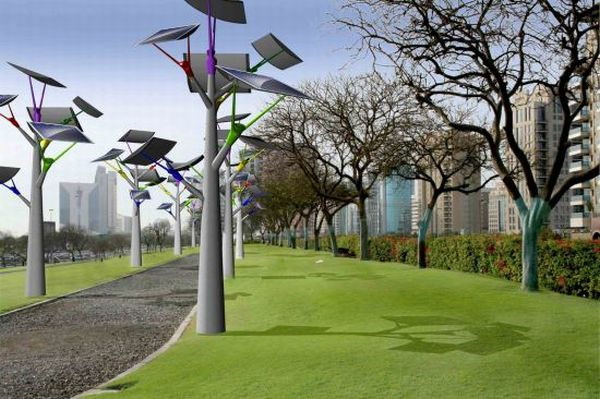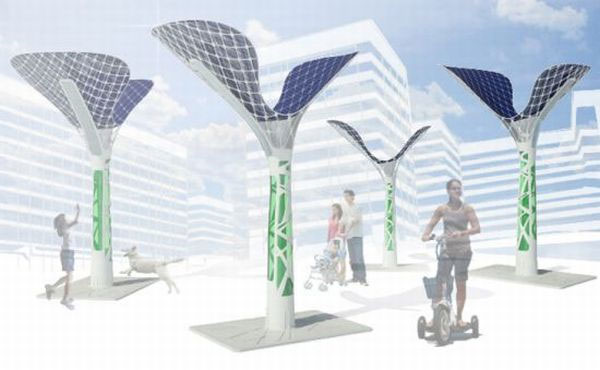10 samples of artificial plants reduce city pollution in the future
Exploiting energy by growing artificial plants will certainly be an effective method to be applied in the future.
1. Model of street lamp

Concpet artificial plants lighting the street thanks to solar energy, is the idea of Vinaccia Integral Designers. These artificial plants will collect solar energy during the day to generate electricity to light the street at night. The trunk is made of light aluminum material with six branches spread out around and each branch is placed with solar cells of transparent silicon, at different angles, ensuring maximum energy is obtained. heaven at all times of the day. Each branch can generate 100W power. Electric energy is kept in a battery and is capable of generating electricity that shines 48W LEDs.
2. WARP form

Water and Air Recycling Pad (WARP) is designed by Water and Air Recycling Pad with the main purpose: to reduce the damage caused by indiscriminate tree felling. For this purpose, WARP artificial plants will help to recycle air and maintain moisture. The energy obtained from the sun will ensure the use of photovoltaic panels, a place to store water that is connected to four algae tanks and the whole system is connected to the communication system, the network water, power stations and biodiesel production vessels. Algae placed in a water storage tank will transfer energy as required. In addition, the plant is also fitted with two LED lights for lighting at night and an outlet for charging electric vehicles below.
3. Concept of Anthony DiMari

Anthony DiMari expanded the idea of his artificial plants to apply in inner city areas. This design not only provides energy, from renewable energy sources, but also can store rainwater. The tree is made of synthetic fibers and surrounded by a voltage field and they will absorb rainwater and move underground, converting into electrical energy. In addition, these artificial plants are arranged in a certain order to combine the use of wind and solar energy. This will be the idea of creating green parks in urban areas.
4. Glowing tree - Light Tree

Omar Huerta designed the Light Tree model to generate electricity from solar energy. Inside the trunk is filled with water, which functions as a transmission line to LED bulbs to help the tree glow in the evening. At the same time, hydroponic techniques are also applied to this design by sowing seeds on the top of the tree and these seeds will grow right on the artificial stem.
5. SonUmbra solar interactive tree

This model is named SonUmbra and is made from luminous fabric. These special fabrics are woven together into a net like glowing branches. In the daytime, the plant also collects energy for lighting from solar energy and is stored in batteries. At night, the reserved energy source will be created so that sound and light interact with each other.
6. UTree sample of Xabier Perez

UTree (Urban Photovoltaic Tree) is a model of artificial plants that can be applied in practice most. The energy taken from the sun's rays during the day will be converted into electrical energy to light up traffic lights, street lights, and other public lighting systems. UTree is designed with a wide and flat foliage, each with 77 solar cells attached and capable of producing 2.5W of electricity. In particular, this model does not occupy much area and can be rotated to ensure maximum sunlight reception, easy installation and removal.
7. Plants using Nanoleaf technology

This design uses the main 'Nanoleaf' technology, to create renewable sources of energy from the sun, wind and rain. 'Nanoleaf' includes many solar cells, heat-retaining cells and branches. Solar energy will be powered by solar cells while wind energy when blowing through the branches also creates a useful source of energy. According to the researchers, growing a tree every 6 km will provide enough electricity for a single apartment.
8. Ross Lovegrove artificial plants

Ross Lovegrove's solar plant is a combination of science and art. They were also used to light the Ringstrasse street during the Vienna Design week. With this model, you can comfortably charge your phone, computer or other similar electrical devices.
9. Trees collecting CO2 emissions

Dr. Klaus Lackner from Columbia University is the author of this creation. His design not only creates energy but is also useful in global warming. This model looks like an electric fan with a height of over 300m, the wing part is made of liquid hydrogen hydrogen. The work of the plant is similar to the real plant photosynthesis and is capable of generating 3MW of energy, gaining 90,000 tons of CO 2 waste. Therefore, this design will definitely bring clean air to the city in the future.
10. Nissan's design

At the most advanced Electronics and Information Technology Exhibition 2010 (CEATEC 2010), Nissan introduced a solar-powered artificial plant for future polluted cities. This solar tree consists of three solar panels with a translucent glass surface to maximize sunlight, creating a 30% higher efficiency than normal solar cells. In addition, the panels also have the ability to track the location of sunlight shining from time to time during the day. With about 1000 trees planted on the highway will generate electricity for 1000 households.
- City of the future: Floating, clean and vertical
- China announced plans to clean the air
- Artificial green plants
- Artificial rain reduces dust on the street
- 7 simple ways to reduce air pollution in your home
- Artificial plants can create oxygen
- Growing wild plants, Beijing turned into a huge pollution trap?
- New street lamp design helps reduce light pollution
- Beijing uses rain to wash away contaminated smoke
- Saudi Arabia's $ 500 billion city uses the artificial moon
- Hanoi seeks to reduce air pollution
- China decided to reduce car smoke to cope with pollution
 Is the magnetic North Pole shift dangerous to humanity?
Is the magnetic North Pole shift dangerous to humanity? Washington legalizes the recycling of human bodies into fertilizer
Washington legalizes the recycling of human bodies into fertilizer Lightning stone - the mysterious guest
Lightning stone - the mysterious guest Stunned by the mysterious sunset, strange appearance
Stunned by the mysterious sunset, strange appearance